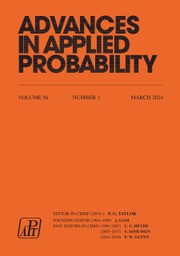Article contents
Leaving an interval in limited playing time
Published online by Cambridge University Press: 01 July 2016
Abstract
A player starts at x in (-G, G) and attempts to leave the interval in a limited playing time. In the discrete-time problem, G is a positive integer and the position is described by a random walk starting at integer x, with mean increments zero, and variance increment chosen by the player from [0, 1] at each integer playing time. In the continuous-time problem, the player's position is described by an Ito diffusion process with infinitesimal mean parameter zero and infinitesimal diffusion parameter chosen by the player from [0, 1] at each time instant of play. To maximize the probability of leaving the interval (–G, G) in a limited playing time, the player should play boldly by always choosing largest possible variance increment in the discrete-time setting and largest possible diffusion parameter in the continuous-time setting, until the player leaves the interval. In the discrete-time setting, this result affirms a conjecture of Spencer. In the continuous-time setting, the value function of play is identified.
Keywords
Information
- Type
- Research Article
- Information
- Copyright
- Copyright © Applied Probability Trust 1988
Footnotes
Supported in part by the U.S. Army Research Office through the Mathematical Sciences Institute at Cornell University and by a grant from the AT&T Foundation.
Supported in part by National Science Foundation grants DMS-84–01604 and DMS-86–01153.
References
- 2
- Cited by

